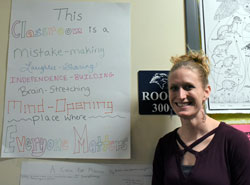Oh, Marcus! He’s always crushing or dropping his cell phone, and now he’s broken another one. His parents won’t buy him a new one, unless he can convince them he will keep it safe.
Renae Hackley, sixth grade science teacher at Godwin Heights Middle School, asked her students to help the fictitious Marcus, and over the last several weeks they’ve been hard at work designing protective gear for his phone.
“We’re trying to make a cell phone case that makes it easy for the phone to come out, and it won’t break from dropping it from 70 centimeters or be crushed with seven books on top,” explained Higinio Rolon-Rosado who, along with partner Juan Granados, demonstrated how their foam and fabric design met the challenge.

Tinkering Thinkers
The activity was part of the class’ eight-week physics unit using Mi-STAR, a science curriculum that incorporates real world challenges into every unit. It introduced force and motion, and then let students get their hands dirty — dropping raw eggs on different materials to see if they’d break, for example — before designing the case.
Experimentation involved dropping, crushing and trying to understand the effects of forces on different objects. Weeks of tinkering and observation led to the final challenge of creating the case.
During the experimentation period, Higinio said, his team noticed that an egg did not crack when dropped on a sponge, so they looked for sponge-like materials to use in their design.
Making The Case
Students used cardboard, packing peanuts, fabric, various tape and other repurposed materials found around school or donated by staff to create the cases. Students aren’t allowed to use phones in class, so Hackley simulated them by “gluing” uncooked lasagna noodles and graham crackers with marshmallow creme. Each group received two: one to practice with and one for a final test with their completed case.
“Everyone was actively engaged in the creation of the cell phone case and testing it out,” she said.
Terrence Reynolds and Jada Carew worked together, and were pretty satisfied with their results: “We tested it three times to see if it works,” said Terrence. “To see if it would fall out of the case or stay in, if it would crack, and how much force would it fall with.”
In the end, their phone remained intact and they both learned about forces and motion.
So would the real-world challenge work on Marcus’s “real-world” cell phone?
“We did take one of my old cell phones and drop it in the cases,” Hackley said. “It made it up until my last hour.”













